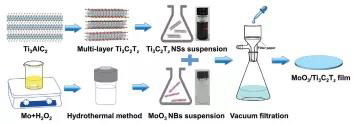


Electrochemical capacitors are a representative type of energy storage device in electrochemical energy storage, because they combine the advantages of high power density, long cycle life and outstanding reliability. However, the energy density of electrochemical capacitors is usually relatively low, which requires maximizing the energy density from both the volume capacity Cv and the mass capacity Cg. Considering that Cv = Cg*ρ, ρ is the electrode density. For most electrochemical capacitors, Cg and ρ influence each other. Electrode materials like activated carbon have a larger specific surface area and fast ion transport behavior, and therefore have a higher Cg value, but a lower density leads to a lower Cv. In contrast, high-density electrodes can generally have a higher Cv, but the ion accessibility decays rapidly, resulting in a lower Cg. Therefore, designing electrodes with high volume capacity and mass capacity at the same time is a top priority.
MoO3 has received extensive attention as a pseudocapacitance material due to its low cost, non-toxicity, high electrochemical activity and stability, especially considering its higher theoretical capacity (1005C g-1). These advantages make it very potential to be an electrode material with high volume capacity and mass capacity at the same time. In particular, the stable layered orthorhombic α-MoO3 phase allows rapid insertion and extraction of ions between the layers without structural collapse. However, its actual specific capacitance is much lower than the theoretical capacity. It is because of its low electronic conductivity, general reaction kinetics and limited exposed active sites. 2D transition metal carbon/nitride, MXenes, due to its ultra-high metal-like conductivity (400-10,000 S cm-1), hydrophilic nature and controllable functional groups make it in the field of energy storage devices It has become a very promising material system, especially for electrochemical capacitor applications.

Recently, Prof. Per O. Å. Persson, Prof. Johanna Rosen and Prof. Michel W. Barsoum of Drexel University in the United States published the title of Flexible Free-Standing MoO3/Ti3C2Tz MXene Composite Films in the internationally renowned academic journal Advanced Science. The research paper with High Gravimetric and Volumetric Capacities reported that a binder-free, flexible self-supporting film composed of Ti3C2Tz and MoO3 nanoribbons with different mass ratios has both high-quality capacity and volumetric capacity.


Figure 1. Schematic diagram of the synthesis process of MoO3/Ti3C2Tz film.

Figure 2. SEM image and element mapping distribution of MoO3/Ti3C2Tz.

Figure 3. XRD and XPS characterization of MoO3/Ti3C2Tz.

Figure 4. Electrochemical performance test of MoO3/Ti3C2Tz.

Figure 5. 8: Electrochemical performance test of 2MoO3/Ti3C2Tz//NAC hybrid capacitor.

Figure 6. 8: Ragone diagram of 2MoO3/Ti3C2Tz//NAC.

The MoO3/Ti3C2Tz film with a mass ratio of 8:2 has a mass capacity of 837 C g-1 and a volume capacity of 1836 C cm-3 at a current density of 1 A g-1. The outstanding electrochemical performance can be attributed to the following points: i) the high conductivity of Ti3C2Tz provides a path for fast electron transmission; ii) the MoO3 nanoribbons alleviate the restacking problem of Ti3C2Tz, exposing more energy storage Iii) The reduction of MoO3 due to the introduction of Ti3C2Tz can further increase the concentration of free carriers and generate more exposed active sites, thereby achieving fast kinetics of charge storage and higher capacity; iv) The open and stable structure of the self-supporting electrode promotes the infiltration of the electrolyte, improves the specific capacitance while extending the cycle performance; v) The synergistic effect between the high density and high capacity Ti3C2Tz and MoO3 makes high volume capacity and mass capacity possible .
Literature link:
DOI: 10.1002/advs.202003656
Source: MXene Frontier
This information is from the Internet for academic exchanges. If there is any infringement, please contact us and delete it immediately













